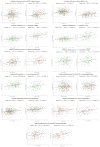Predicting personality from network-based resting-state functional connectivity
- PMID: 29572625
- PMCID: PMC5997535
- DOI: 10.1007/s00429-018-1651-z
Predicting personality from network-based resting-state functional connectivity
Abstract
Personality is associated with variation in all kinds of mental faculties, including affective, social, executive, and memory functioning. The intrinsic dynamics of neural networks underlying these mental functions are reflected in their functional connectivity at rest (RSFC). We, therefore, aimed to probe whether connectivity in functional networks allows predicting individual scores of the five-factor personality model and potential gender differences thereof. We assessed nine meta-analytically derived functional networks, representing social, affective, executive, and mnemonic systems. RSFC of all networks was computed in a sample of 210 males and 210 well-matched females and in a replication sample of 155 males and 155 females. Personality scores were predicted using relevance vector machine in both samples. Cross-validation prediction accuracy was defined as the correlation between true and predicted scores. RSFC within networks representing social, affective, mnemonic, and executive systems significantly predicted self-reported levels of Extraversion, Neuroticism, Agreeableness, and Openness. RSFC patterns of most networks, however, predicted personality traits only either in males or in females. Personality traits can be predicted by patterns of RSFC in specific functional brain networks, providing new insights into the neurobiology of personality. However, as most associations were gender-specific, RSFC-personality relations should not be considered independently of gender.
Keywords: Functional networks; Gender differences; Hormonal influence; Machine learning; NEO-FFI; Resting-state functional connectivity.
Figures




References
-
- Adelstein JS, Shehzad Z, Mennes M, et al. Personality is reflected in the brain’s intrinsic functional architecture. PLoS One. 2011;6:e27633. https://doi.org/10.1371/journal.pone.0027633. - DOI - PMC - PubMed
-
- Alawieh A, Sabra Z, Sabra M, et al. A rich-club organization in brain ischemia protein interaction network. Sci Rep. 2015 https://doi.org/10.1038/srep13513. - DOI - PMC - PubMed
-
- Allen TA, DeYoung CG. Personality neuroscience and the five factor model 2016
-
- Allen EA, Erhardt EB, Damaraju E, et al. A baseline for the multivariate comparison of resting-state networks. Front Syst Neurosci. 2011;5:2. https://doi.org/10.3389/fnsys.2011.00002. - DOI - PMC - PubMed
-
- Arélin K, Mueller K, Barth C, et al. Progesterone mediates brain functional connectivity changes during the menstrual cycle—a pilot resting state MRI study. Front Neurosci. 2015;9:1–11. https://doi.org/10.3389/fnins.2015.00044. - DOI - PMC - PubMed
Publication types
MeSH terms
Substances
Grants and funding
LinkOut - more resources
Full Text Sources
Other Literature Sources

